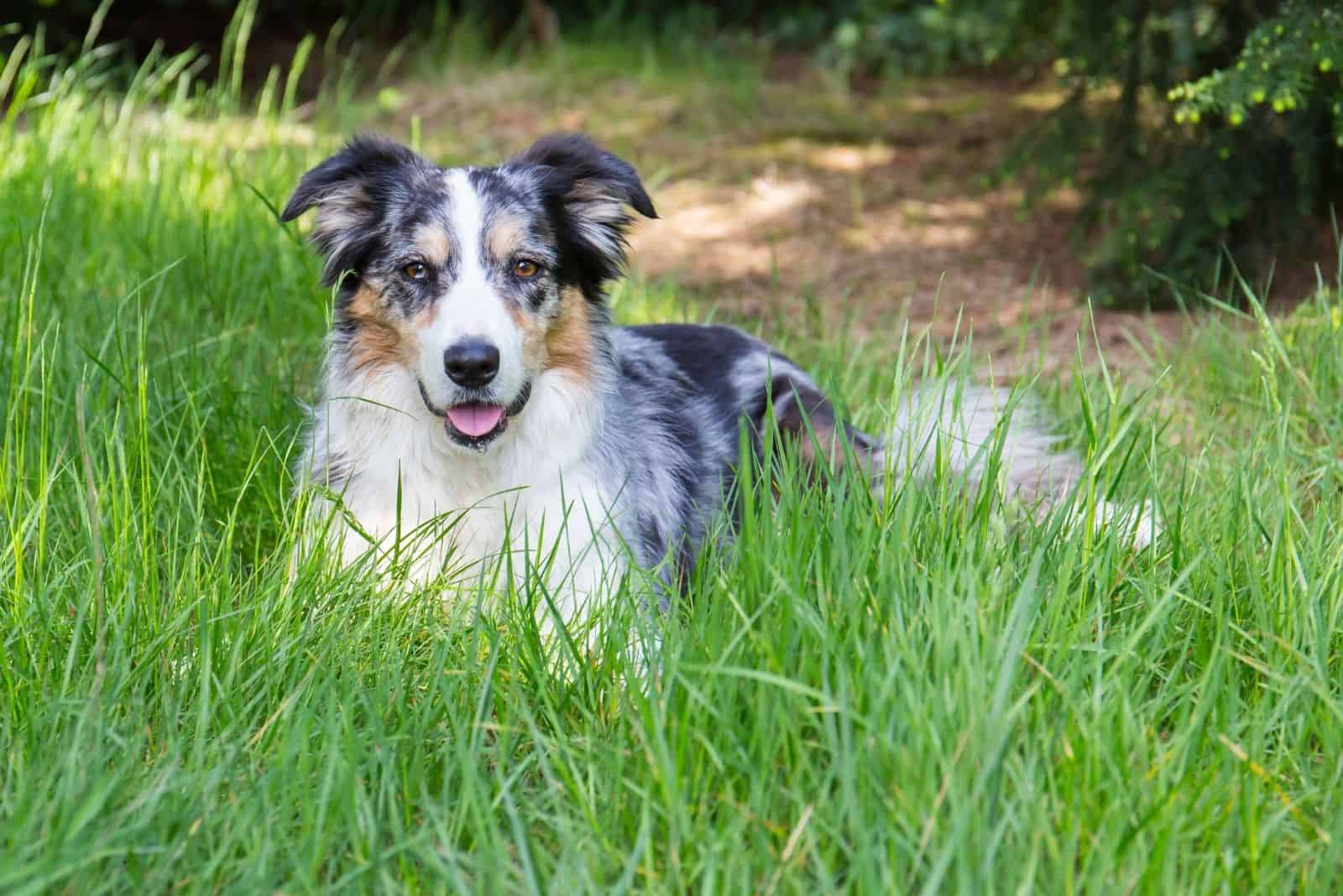The Border Collie is genuinely a one-of-a-kind breed.
Their ancient roots give them a fantastic work ethic, energy, and intelligence while remaining good-looking and recognizable.
The blue merle Border Collie is a unique type of this dog breed, sporting a fun coat pattern while keeping all the characteristics of a great herding dog.
However, there are rumors about this pattern causing specific issues for these dogs.
Is there truth to these claims? Are there things you need to know before getting a blue merle Border Collie as your new pet?
Here’s what you need to know!
How Old Is The Border Collie Breed?

Border Collies are descendants of a dog type hailing from Scotland, landrace collies.
The breed was named after the Anglo-Scottish border, where it originated from.
While the phrase ‘collie’ was used for these dogs later on, the word itself has origins in the Scottish and Celtic languages, meaning ‘useful.’
One of the oldest known Border Collies was Old Hemp, a tricolor dog from Northumberland. He was born back in 1893 and lived until 1901.
He is believed to be the first of the new Border Collie breed.
In fact, it is assumed that all purebred Border Collies are descendants of Old Hemp, as he was the father of more than 200 puppies.
However, a small strand of Border Collies originates from Hindhope Jed, the first Border Collie imported to New Zealand.
Still, there are some speculations that even Jed was Old Hemp’s son, as he is a few years younger than him.
At the time of his move to New Zealand, Hindhope Jed already had a well-known herding career, and he was considered the best dog who crossed the equator.
A few years later, Hindhope Jed was once again moved, this time to Australia, where he continued winning sheepdog trials.
He is even connected with many Australian Shepherd breeds.
Breed Standards
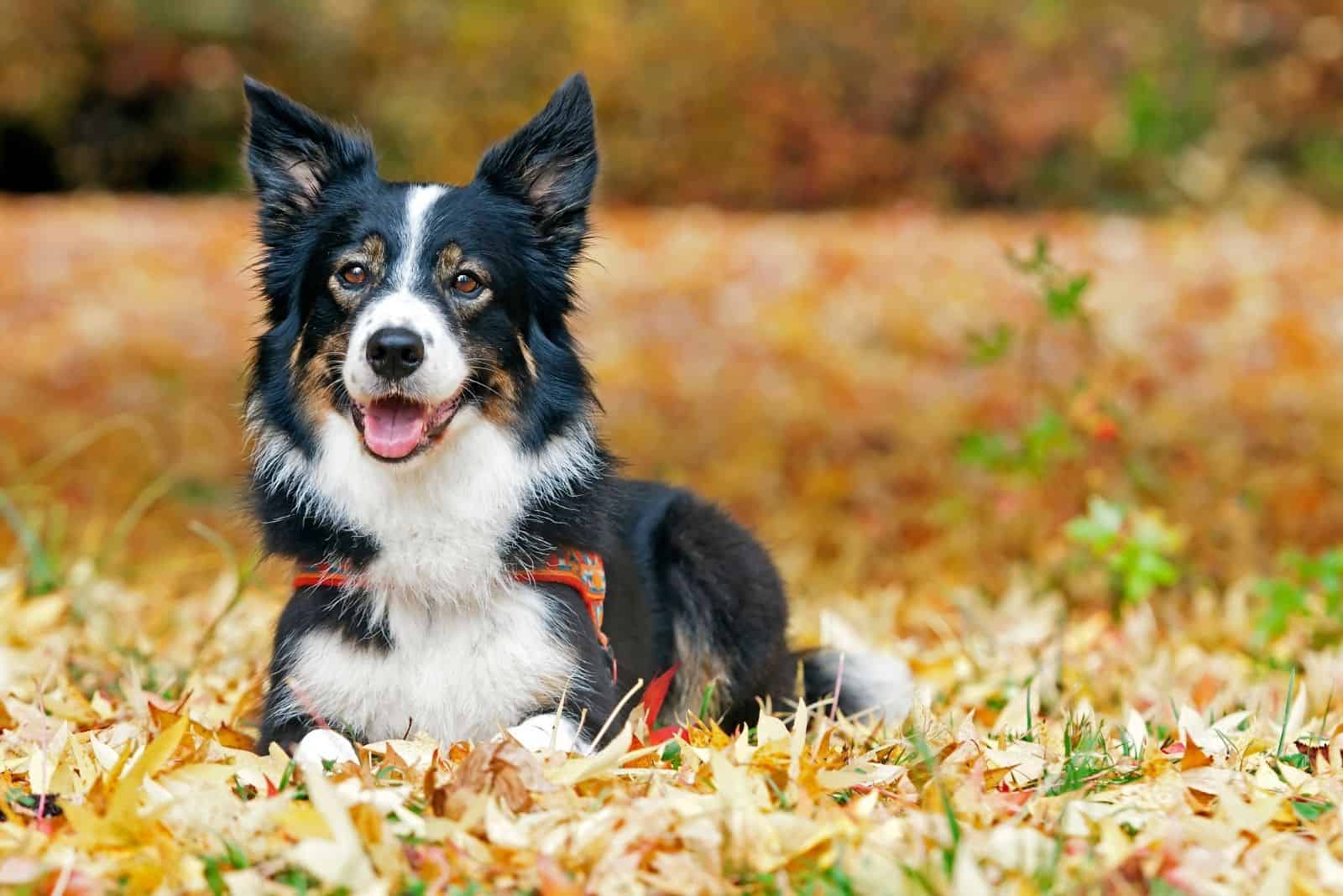
According to the American Kennel Club (AKC), Border Collies are a medium-sized dog breed that reaches up to 22 inches in height and no more than 55 lbs in weight.
They have a life span between 12 and 15 years, so they are relatively long-lived.
They have dark eyes with an intelligent expression, or what is known as the ‘herding eye.’
Believe it or not, this gaze is the breed hallmark, and every Border Collie should have it to be according to standards.
Border Collies are loyal, hard-working dogs. They are extremely intelligent and need plenty of exercise and mental stimulation to keep them happy, otherwise, they can get restless at night.
Don’t worry if your Border Collie is refusing to walk with you, as there is always an alternative. These are great dogs to take swimming with you!
However, they can be a bit shy of strangers, which also makes them excellent watchdogs.
Also, their strong herding instincts can make them difficult with children, so make sure you’ve socialized your pup well to avoid any future trouble.
Border Collie Fur Color

Border Collies can have one of two coat types. Both are weather-resistant, dense double coats.
The smooth coat is short and coarse, while the rough coat is longer and feathered.
Both coat types require the same amount of grooming, and this includes using a pin brush over your pup’s entire body once a weak – unless more is needed.
This will keep his coat free of tangles, matting, dirt, and debris.
However, Border Collies experience more hair loss during the spring shedding season. During that period, you should brush them daily.
Both the Border Collie Society of America (BCSA) and the AKC recognize many colors that this dog breed can have. In fact, they can come in almost the same number of shades as colorful breeds such as Shih Tzus and Poodles!
It’s very rare for a Collie to have only one solid color. Instead, they are usually bicolor, tricolor, tickled, merle, or speckled. They might also come in steel, slate, and gold.
One of the most beautiful color variations is certainly the blue merle Border Collie.
Blue Merle Border Collie
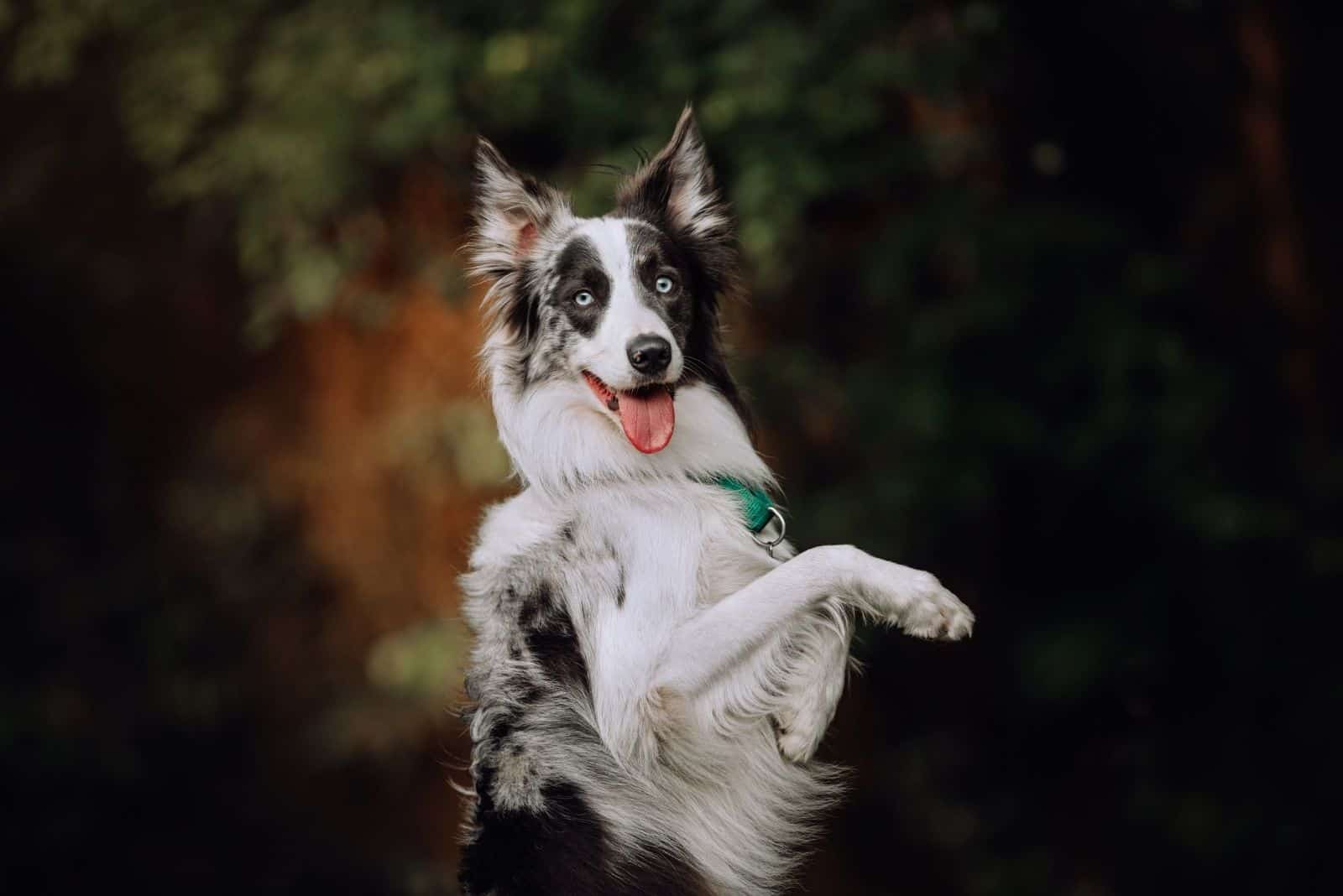
While many consider merle to be a specific color, it is, in fact, a pattern.
The term ‘merle’ was coined in the early 2000s, but the pattern itself had been sought after many decades prior.
On some occasions, the merle pattern can be called dapple.
You can see this color pattern in Australian Shepherds, Cardigan Welsh Corgis, Pitbulls, Dachshunds, and Great Danes.
The merle pattern can appear in several shapes. It can be in the form of irregular, dark patches, streaks, or smudges over a lighter (or, rather, diluted) base shade of the coat.
Border Collies are a breed that comes in many colors and patterns. This includes blue, blue and white, red, red and white, saddleback sable, brindle, black and white, etc.
However, the merle pattern – especially the blue merle – is quite rare.
So, the blue merle Border Collie is a regular Collie, but with a specific blue merle color pattern.
Other merle color combinations include red merle, blue merle with white, lilac merle, and white and red merle.
No matter the color, the merle pattern is genetic. In other words, it has to be inherited from a parent with the merle gene. We’ll explain more further on.
The Genetics Behind The Merle
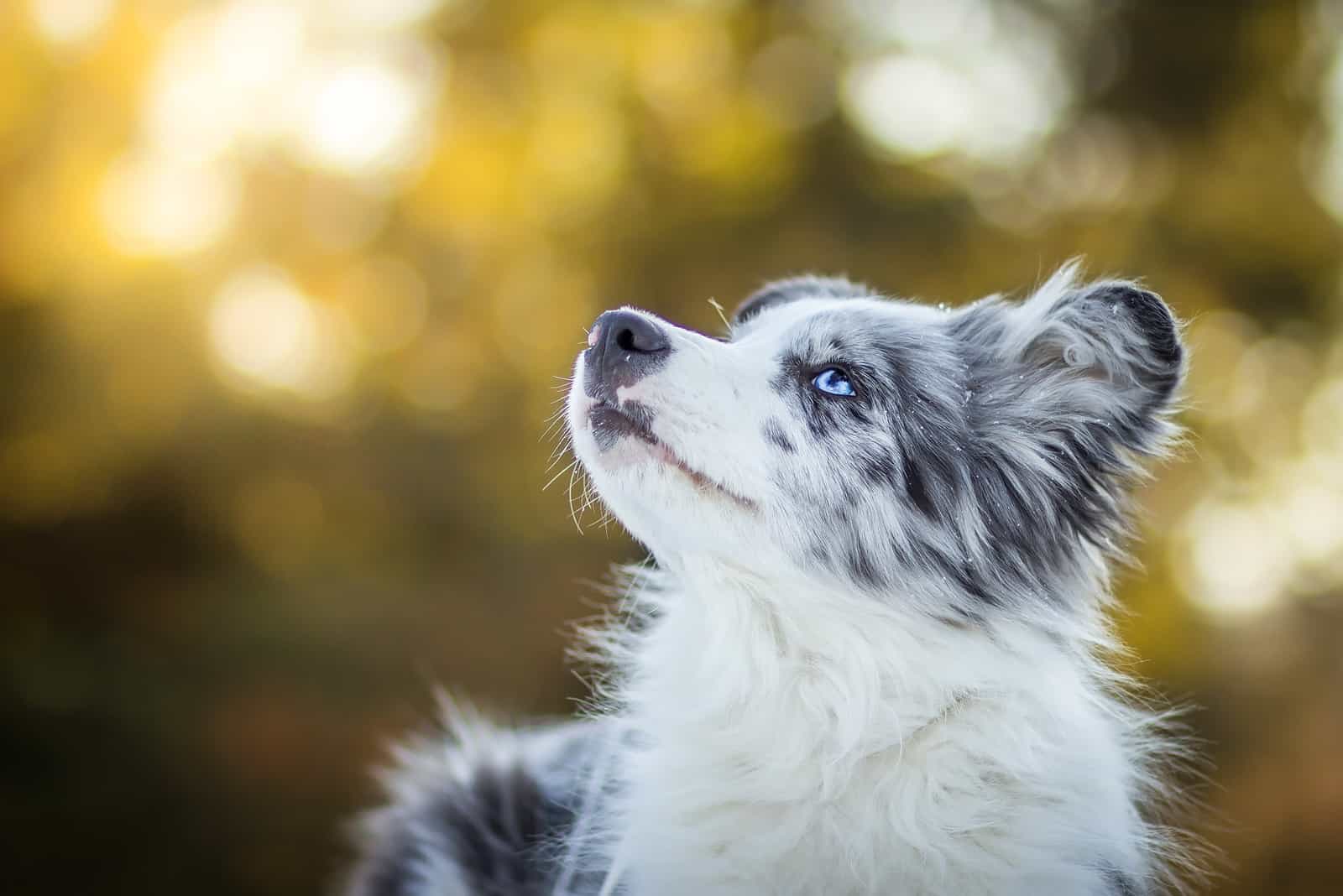
Genetics can be very complicated, especially if you’re new to the subject. We’ll try to make things as simple as possible.
A dog’s coat is made from two base colors – two color genes are inherited, one from its mother and another from its father.
These genes can either be dominant or recessive.
A dominant gene means that it’ll always exhibit itself. Plainly said, it is the stronger of the two gene types.
On the other hand, recessive genes can remain hidden for generations until two parents with the same recessive genes combine.
There is usually a 50/50 chance of any color exhibiting itself if two dominant or two recessive genes combine.
Of course, there are some exceptions, but we won’t focus too much on that.
To breed a blue merle Border Collie, at least one of the parents should carry the merle gene, and the other one usually carries some other dominant color gene.
Once the two genes combine, the merle gene will dilute the dominant color, creating that distinguishable merle pattern.
For example, a combination of the merle and black color gene will result in a dog with a bluish shade with splotchy and swirly streaks.
Keep in mind that just because one merle parent participates in the breeding process doesn’t mean its puppies will also have that same color.
It isn’t rare to have just one blue merle Border Collie puppy in the entire litter!
There is another variation of the merle pattern, the cryptic merle, also known as a ghost merle or phantom merle.
Cryptic merle means the dog carries the merle gene, but it remains hidden. The dog’s coat will appear liver or black as if the merle wasn’t there.
Sometimes, a few merle areas will be noticeable.
Eye Color
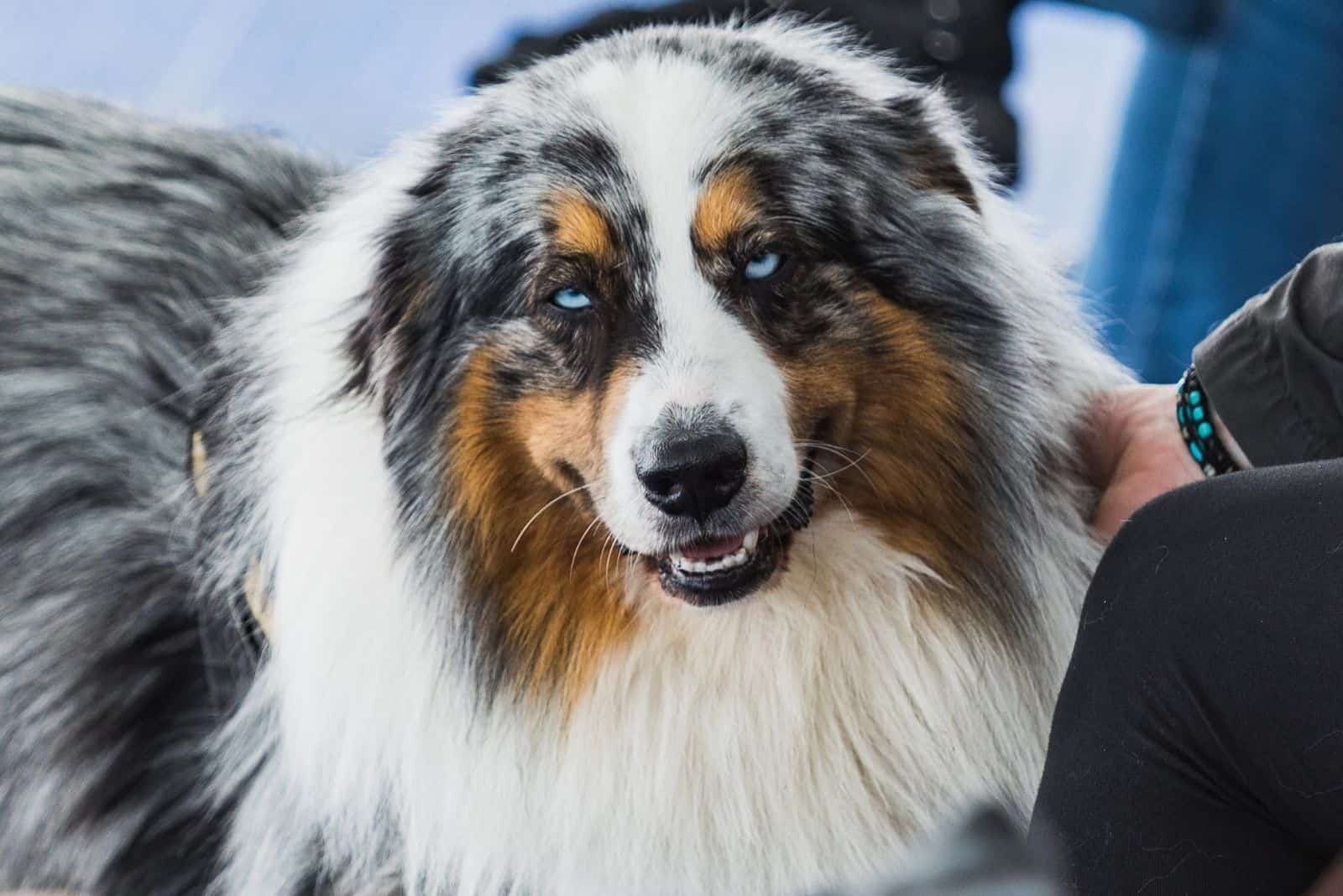
The fur color isn’t the only thing the merle gene will dilute. In fact, it will also cause discoloration to your pooch’s skin and eyes.
Unlike regular, dark-eyed Border Collies, blue merle Border Collies can have pale blue, light green, or faded amber-colored eyes.
When combined with their intense glare, this makes them truly beautiful dogs.
Heterochromia, or mismatched eye colors, is also quite common in blue merle Border Collies. They can have one brown eye and one blue eye.
In fact, you may even find a blue merle Collie with partial heterochromia, meaning one eye is partially brown and blue!
The Personality Of A Blue Merle Border Collie
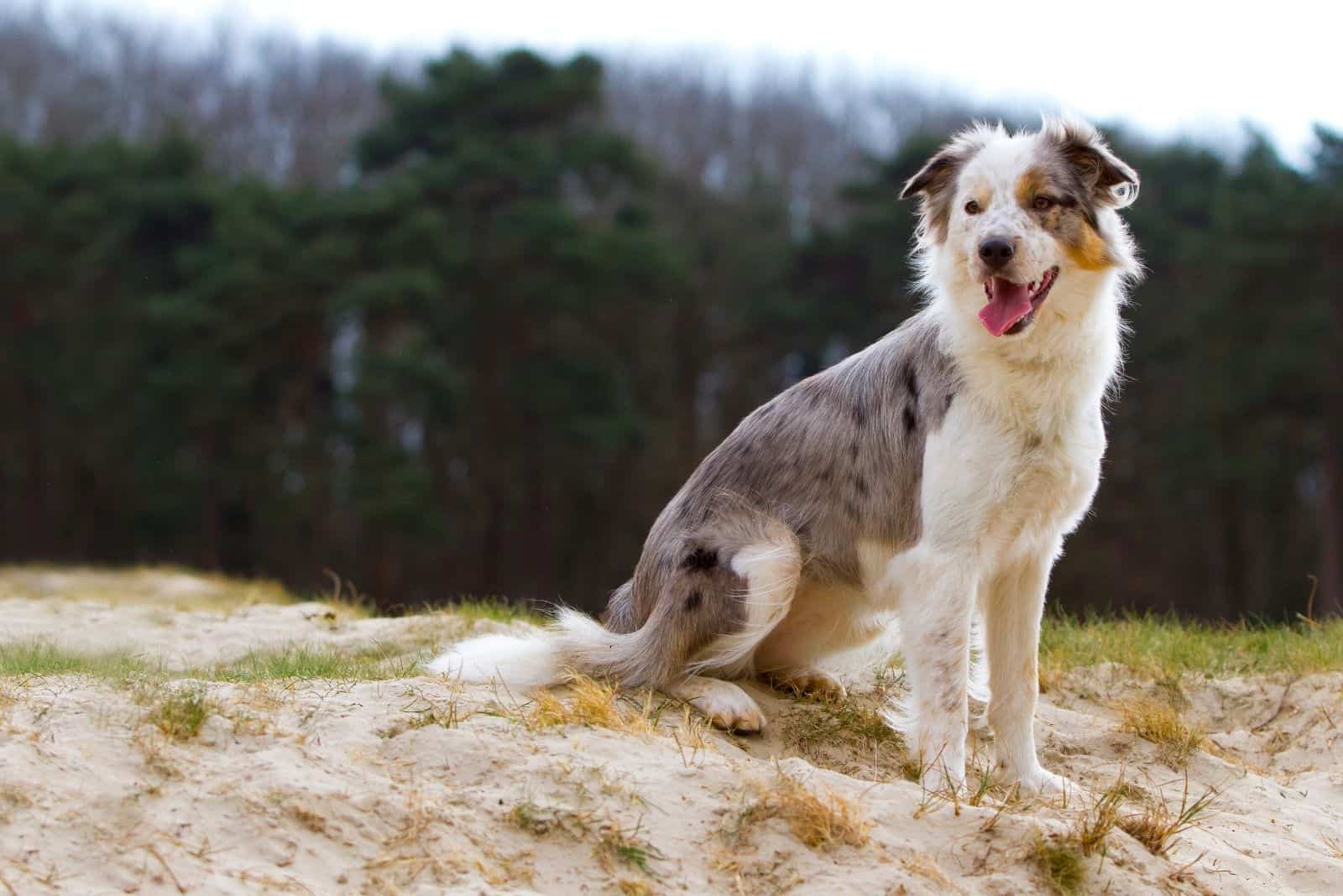
All purebred Collies have many similarities in their temperament and behavior.
The color pattern can’t affect this. While some issues with the merle gene exist, these aren’t related to a dog’s personality.
This means that blue merle Border Collies have the same temperament as regular Collies.
They are intelligent dogs that are also agile, energetic, athletic, and very eager to please. All of this makes them not just great herding dogs but also excellent family pets.
In fact, the Border Collie’s personality can depend more on the dog’s gender than on the coat color it sports!
It is worth noting that coat color doesn’t influence a Collie’s ability to herd cattle. They will still do their job flawlessly, just like Old Hemp did before them.
How Should You Train Them?
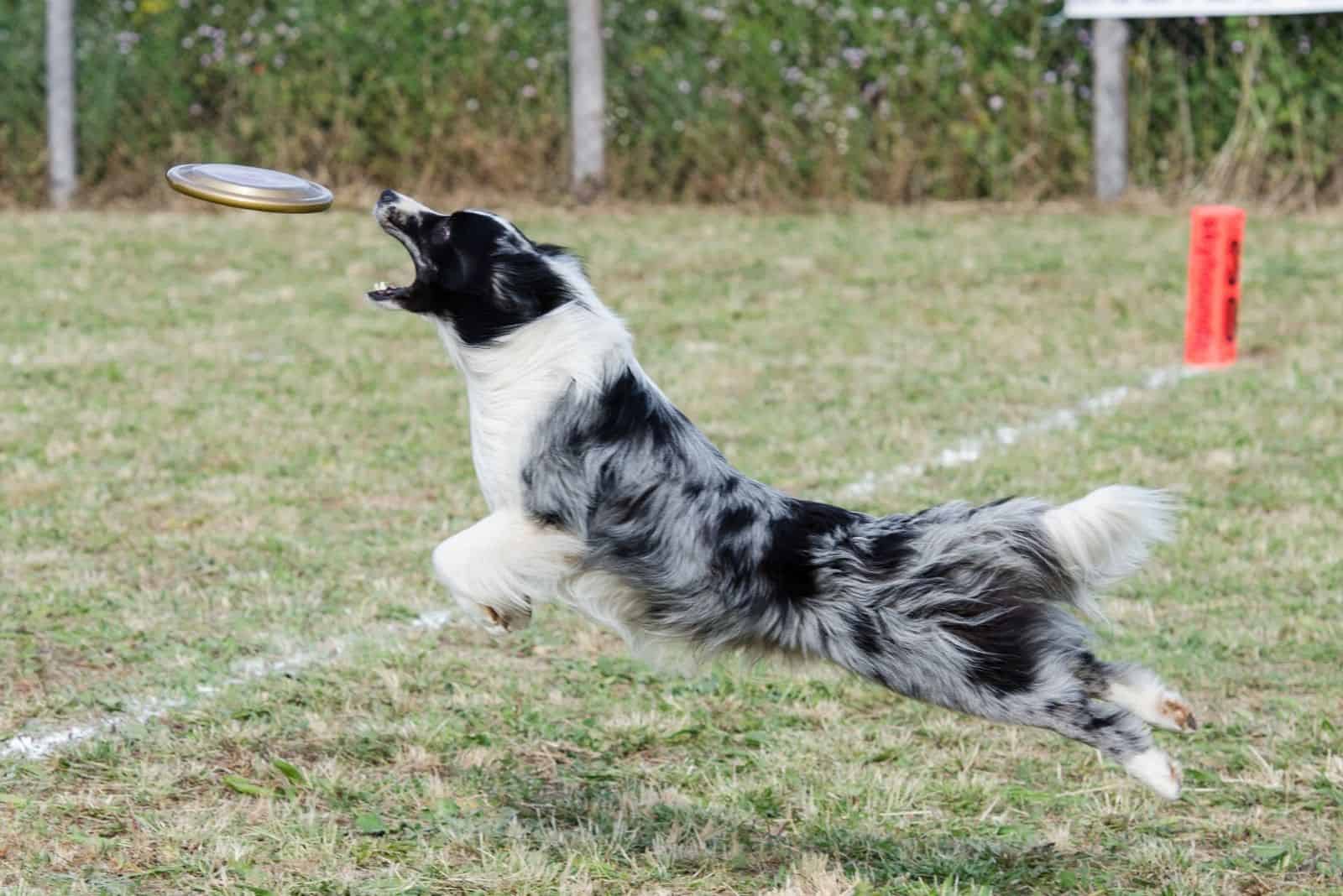
While blue merle Border Collies love being around people, some training is still necessary.
Any dog that isn’t properly socialized and taught to obey commands can become quite a hazard.
While Collies are great house pets, they might not do so well with little children, so you should always keep an eye on them.
They have very strong herding instincts, causing them to nip the heels of anything that runs around – and kids are the primary victims.
This doesn’t mean these dogs don’t love their humans or that they cannot be kept if you have kids.
However, it would be best to take extra time to socialize and train them to be well-behaved.
While your blue merle Border Collie is still a puppy, take him to see different places. Introduce him to different people, noises, and smells.
You might even train him to do some chores! Collies love helping their humans, and this can also be fantastic mental stimulation.
Nutrition And Grooming
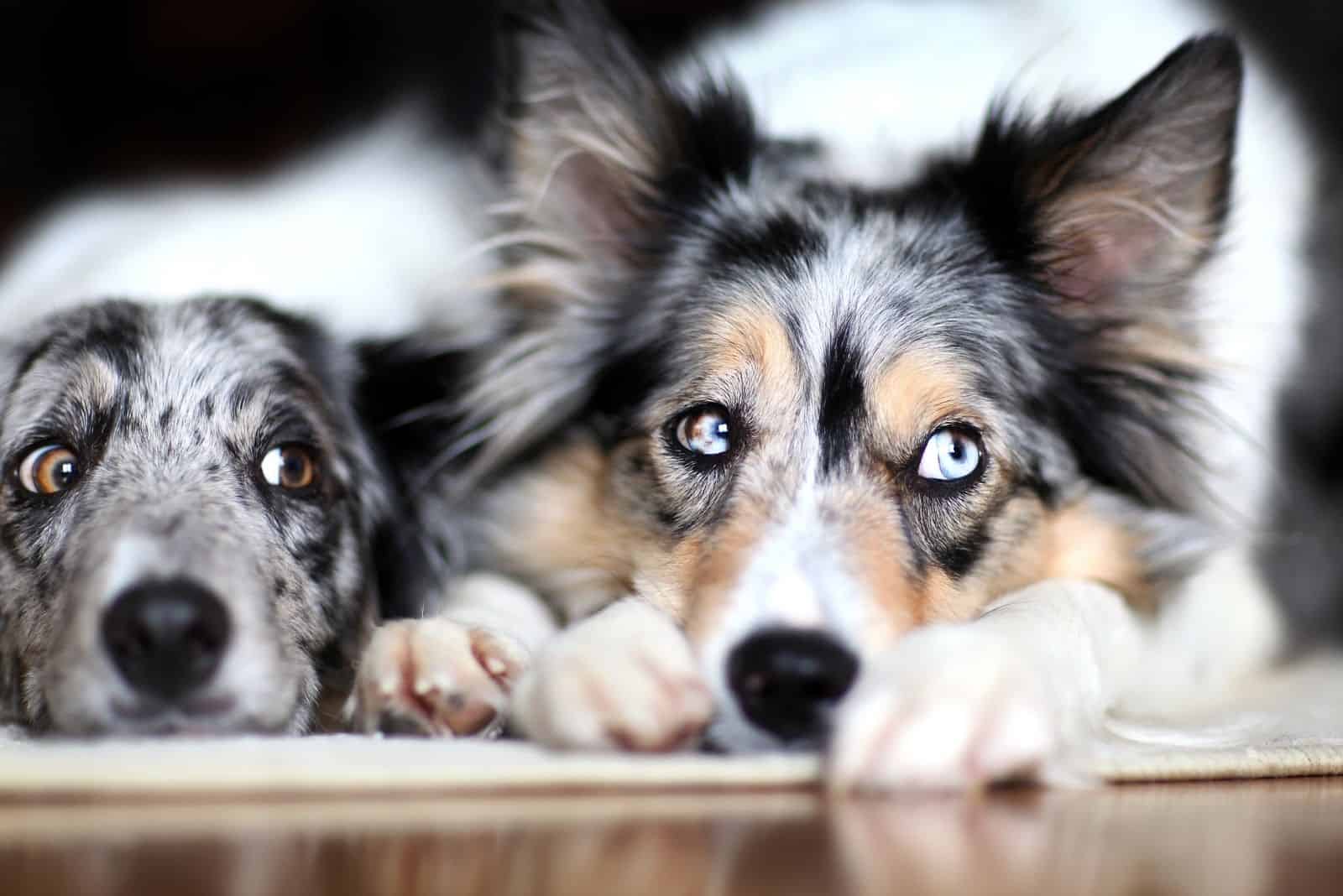
While his color pattern is unique, you don’t have to take extra care grooming your blue merle Border Collie.
His double-layer coat protects him from both the heat and cold, but it will shed, especially when the seasons change.
As we’ve already mentioned, it would be best to brush your merle Collie at least once a week. This should be done more regularly once the shedding season starts.
Also, blue merle Border Collies have both dark and white colors in their fur. This means that any dirt will be visible on them, especially on the lighter hairs.
Many Collie owners bathe them every few weeks – but you shouldn’t do this more than every three months unless absolutely necessary.
You should also clean your Collie’s ears every now and then, and it would be great if you could trim its nails every two to three weeks as they are prone to splitting and cracking.
As for diet, every Collie should eat dog food suited to its health, size, age, and activity levels.
It’s especially important to give your blue merle Border Collie a high-quality food rich in vitamins and minerals.
If you’re unsure where to buy such foods, you can always purchase them from Amazon or other similar websites.
If your Collie isn’t very active, you should give him no more than 1,000 calories daily.
However, if he’s a working dog, especially if he spends most of his time in the field, you should increase this to around 1,400 calories. Find out more on this dog’s nutrition in our Border Collie feeding chart.
As for the amount of exercise, Collies are very active dogs.
It will help if you do all you can to give them long walks, take them jogging, bring them along on hikes, participate in flyball tournaments, or any other physical activity you two can both do.
An active Collie is a healthy Collie!
Other Variations Of Merle Border Collies
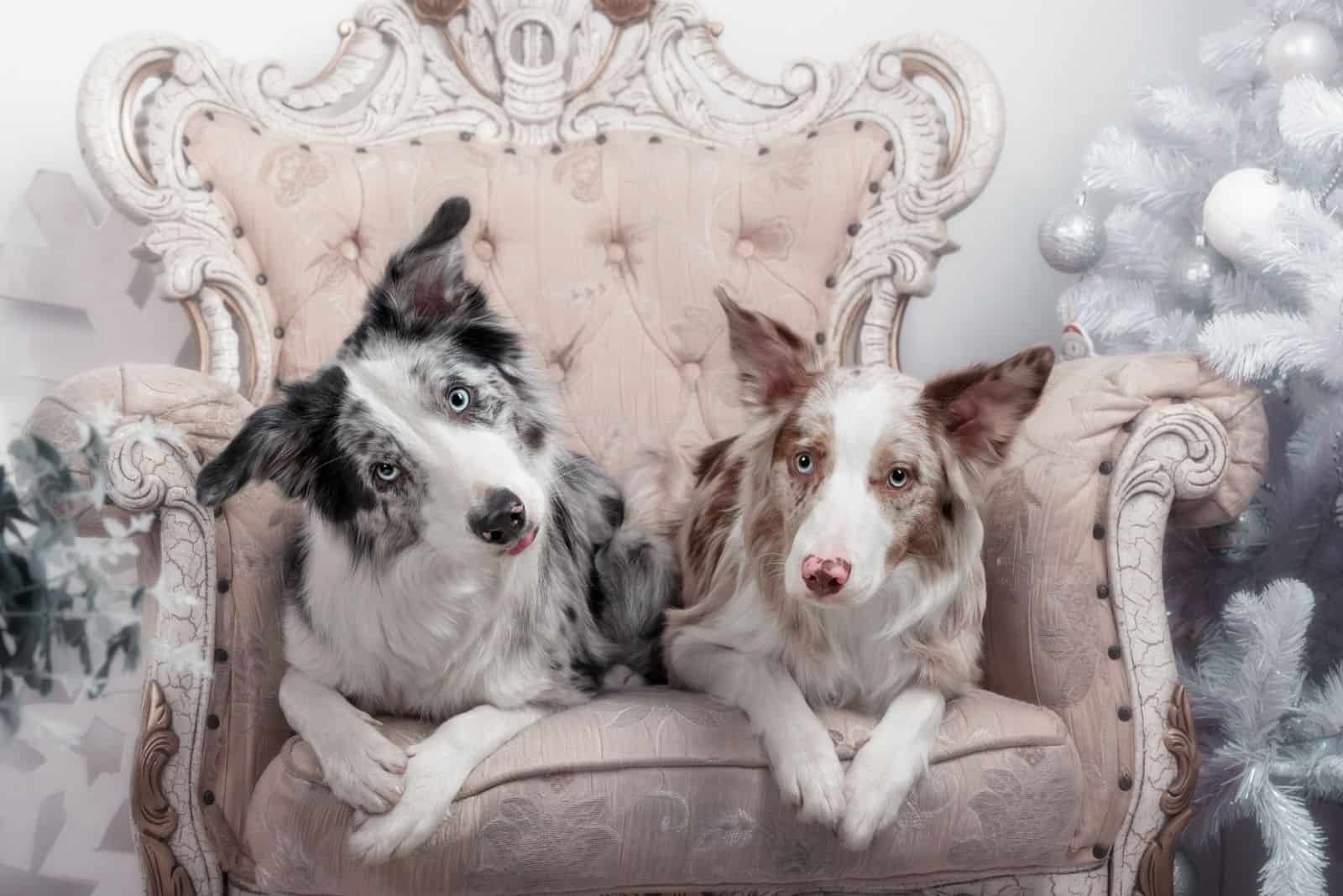
While you might be most familiar with blue merle Border Collies, other types of merle colorations exist.
All are very popular and in demand, and the waiting lists for a puppy can be quite long.
Red Merle
Red merle Border Collies are quite similar to blue merle Collies, except their base color is red. With a dilution gene, their color becomes more cream or orange.
It isn’t rare for red Collies to be cryptic merles. This is because the red gene is also recessive, and sometimes it can be the one that shows up on the dog’s fur.
Due to this, red merle Border Collies are somewhat rare.
Lilac Merle
These Border Collies have a chocolate and blue base, together with the merle gene. This gives them a color that is somewhere between gray and silver.
Lilac merles rarely have any dark patches or streaks. Instead, they have splotches.
Some people confuse lilac merles with cream dogs with some patterns, but it isn’t hard to spot the difference.
A lilac merle Border Collie will always have light-colored eyes, and its fur will be duller in color than cream a Collie’s.
Slate Merle
Slate merles are tricolor, and they are quite noticeable.
They have diluted blue splotches, joined with black areas and a white base. They have quite a unique look and can never be cryptic merle.
Sable Merle
Sable merle Border Collies are born from a sable and a merle Collie. They are another merle type that is quite noticeable and difficult to miss.
They usually have a brown base, with either orange, cream, or pinkish markings and white areas. This gives them a distinctive, rusty look.
Harlequin Merle
These cute merles always have one non-merle parent. Otherwise, the markings won’t show up as they should.
They are mostly white, with black, gray, or brown spots located on their heads, tails, and/or bodies.
Sometimes, they’ll even have markings on their legs and faces!
Complications
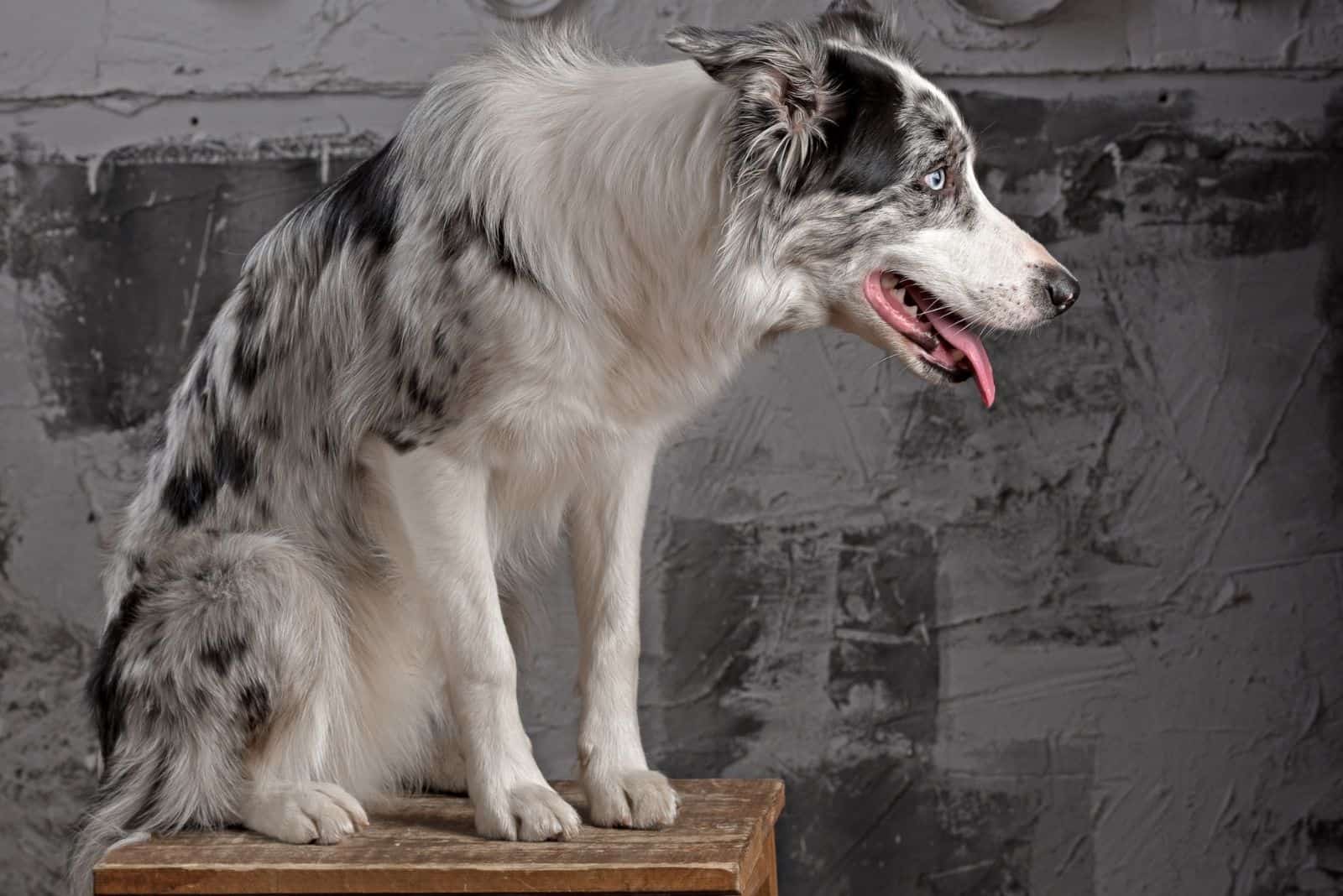
Without a merle parent, there can’t be blue merle Border Collie puppies.
However, having one merle dog doesn’t guarantee its offspring will also be merle.
Because of this, some breeders create double merle dogs, creating homozygous genetics.
In fact, lately, this has been the most common way people get their hands on a blue merle Collie.
Sadly, breeding a double merle Border Collie is never a good idea.
In fact, buying any dog and not just a Border Collie with a merle gene comes with its own set of worries.
The reason behind this might surprise you.
Several studies have discovered that some genes that dilute the coat color can lead to many health issues in dogs.
The colors and patterns with these problematic genetics are:
• Merle
• Piebald
• White
• Roan
Border Collies are generally a healthy breed. If you take good care of them, they can live long and happy lives.
However, just like with any purebred canine, there are some health complications that a dog’s genetics will carry.
For example, Border Collies will be susceptible to hip dysplasia, epilepsy, Collie eye anomaly (CEA), as well as progressive retinal atrophy (PRA).
It’s essential to know you’re getting a dog from a reputable breeder, so you can always be able to check if your pup has a higher chance of developing certain health issues.
When it comes to blue merle Border Collies, you have to be extra careful, as this pattern comes with plenty of problematic features.
Maybe you’ve heard of ‘lethal white’ when it comes to talking about a dog’s health condition. Did you know that these dogs are actually double merles?
If a dog has two merle parents, there will be no color left to dilute.
This can typically leave you with white dogs with blue eyes – although some merle puppies can be found in these litters, as well.
If you breed two merle parents, you have about a 25% chance of producing a blue double merle Border Collie Puppy.
Even when you don’t have a double merle pup, you may notice that most merle dogs have lighter ears, heads, chests, and eyes.
This means the gene is the strongest in these particular areas of the body.
Unfortunately, this also means that the merle gene will likely dilute not just the fur color but also the nerves inside the dog’s ears and the cells of its eyes.
Because of this, it isn’t rare for double merle dogs to experience vision and hearing problems or even complete blindness and deafness.
Double merle genes might also cause bone and cardiac issues.
They also increase the chances of any of the standard Collie diseases appearing as your pooch grows older.
According to the American Border Collie Association, deafness has many causes, whether it’s inherited or congenital.
However, it is much more prevalent in dogs with merle, roan, and piebald coats.
It’ll also commonly affect dogs with blue eyes and pups with bright patches on the top of their heads.
Because of this, most experts recommend spaying and neutering blue merle Border Collies, so their faulty genetics and health problems won’t spread.
Breeders, however, aren’t listening to them.
If you happen to get a blue merle Border Collie just to realize he is deaf or blind, don’t worry. Unlike humans, animals can quickly adapt to being left without one sense.
Sure, a deaf Border Collie might take some getting used to, but nothing is stopping it from being the best family pet possible – as long as you can deal with an even louder bark than the one that would come from a regular Border Collie!
Still, we’d recommend getting a blue merle Border Collie who has at least one parent who is a non-merle. This will ensure some new, healthy genes are in the dog’s bloodline.
Finding The Right Breeder
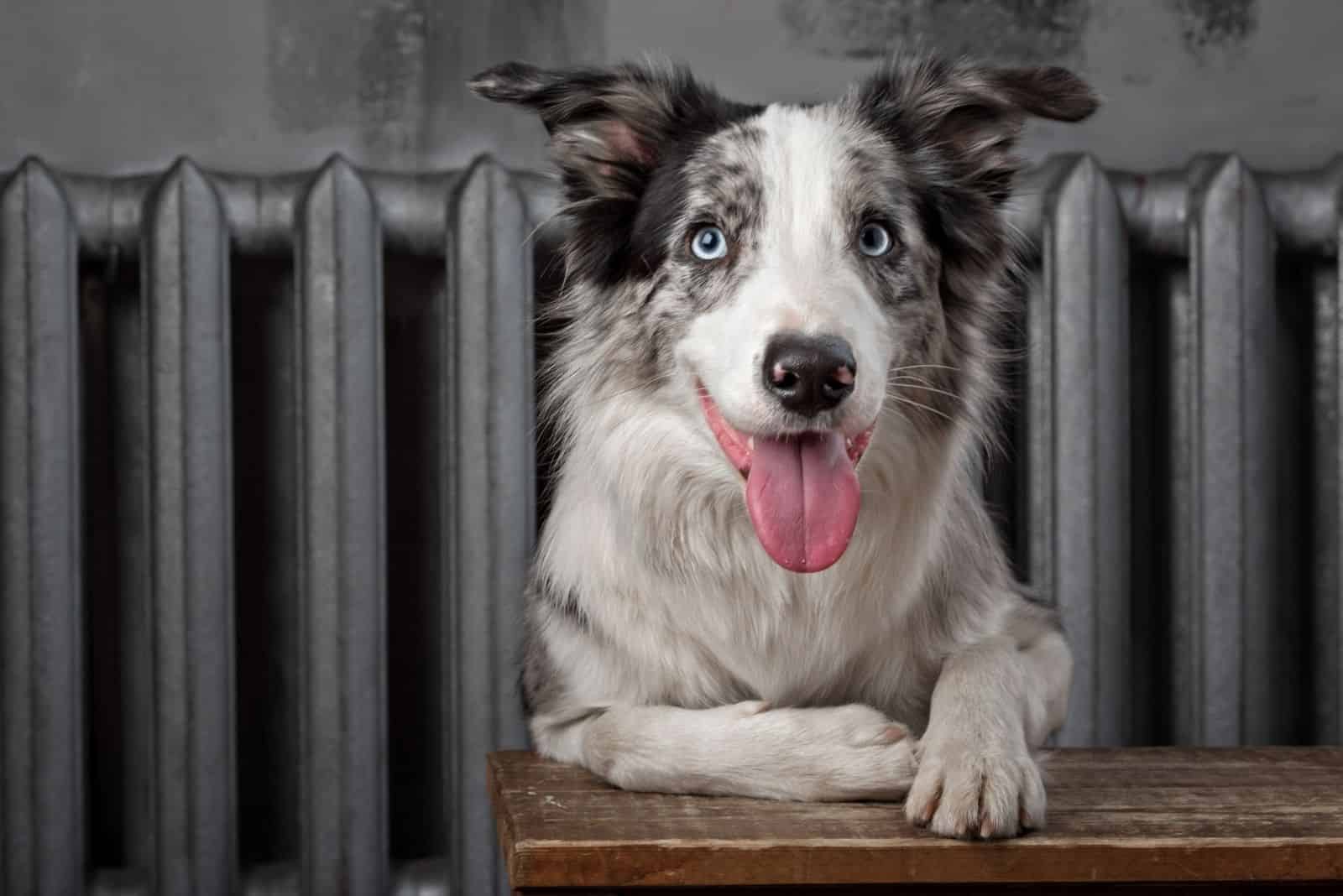
As with any dog breed susceptible to a high number of health problems, you should always get your new puppy from a reputable breeder.
Most good breeders screen their litters to ensure there aren’t any genetic issues with their dogs.
These breeders will be able to provide you with several certificates proving the condition of your puppy’s health before you complete your purchase.
Of course, this is an issue if you’ve adopted your blue merle Border Collie from a shelter, as there is no way of fully knowing his genetics.
Still, there are several genetic and regular tests you can arrange yourself.
If you’re unsure where to start, contact your local Border Collie club, as they might direct you toward an ophthalmologist and orthopedist who will look at your pup’s eyes and bones.
A hip evaluation is also extremely important for your new Border Collie puppy.
Even if the results aren’t the best, don’t panic. There are many things you can do to help your pup live a long and pain-free life.
Should You Get One?
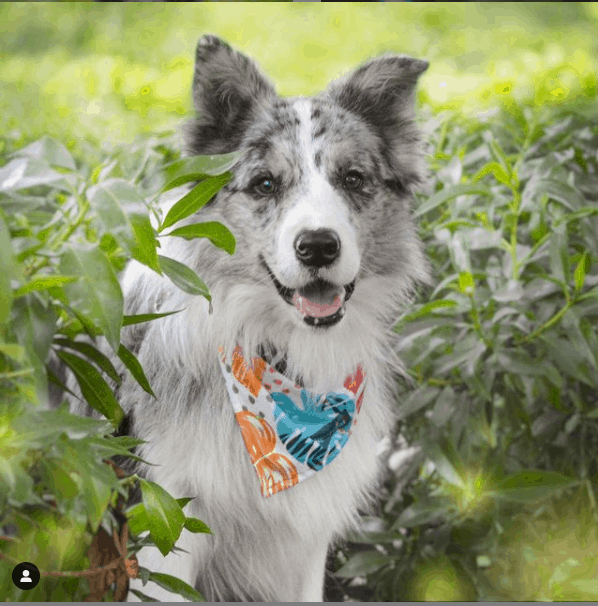
Photo from: @apolo_b_collie
Border Collies are one of the most popular family pets all across the globe, no matter their fur color.
Once people learn their history, they only fall more in love with these hard-working canines.
Personality-wise, blue merle Border Collies are just like regular Collies. The only difference when it comes to their appearance is their unique pattern.
However, these dogs come with several health problems, such as congenital deafness and eye problems. They also have a higher chance of developing other diseases typical for Border Collies.
Aside from that, they are just like any other Border Collie.
While some people don’t support the breeding of dogs with merle genes, others don’t see anything particularly wrong with it. In the end, this gene is a natural occurrence in the breed.
If you do opt to get a blue merle Border Collie, make sure you buy him from a reputable breeder who will give you an insight into the dog’s health records.
And if you adopt and fear your Collie might have some health issues – even blind and deaf dogs can be very happy and comfortable if you know a few tricks to make them feel safe.
Overall, the decision is up to you.
Read Next: Mini Border Collie — Everything You Need To Know


